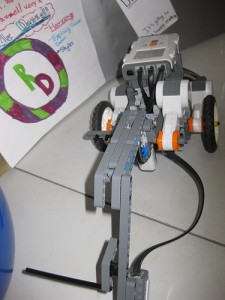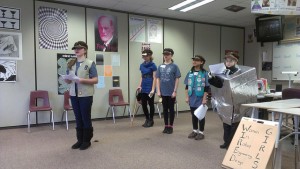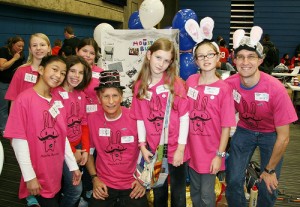Did you know Girl Scouts and robots go hand-in-hand? Gardening, picking up trash, and delivering pills are just a few tasks Girl Scout-engineered robots conquered during this year’s First LEGO League (FLL) competition. We provide girls the opportunity to experiment with Science, Technology, Engineering and Math (STEM) so they can learn about these fields and feel confident they can pursue them in the future. What better way for girls to learn about STEM than by conceptualizing, creating and competing with their very own robots?
In FLL, middle school aged girls get the opportunity to build a robot that can perform tasks to better our world. This year’s theme was Senior Solutions, with the goal to engineer robots to assist the elderly. On command from girls, the robots can do a variety of tasks like stitch a quilt, go up and down an accessible ramp, prep a helper dog for a walk, reach high and low grocery shelves, and do other fun activities like bowling and gardening. Teams even took their robots to nursing homes to present their capabilities. Last year’s theme was food safety and girls are already prepping for next year’s theme: natural disaster preparedness.
Getting Started

This is the seventh year Girl Scouts of the USA (GSUSA) has provided funding to councils to form FIRST teams. Through grants from partnerships with Motorola and United Technologies (UTC), GSUSA currently provides funding to 46 councils for 124 teams, with many additional Girl Scout FLL teams competing as well.
According to the FLL official website, primary activities include building a team, investigating a research topic, preparing a presentation, and building and programming a robot to meet a set of challenges. All of these activities come together in a competition with other teams at a regional tournament. Robots perform different tasks on a 4′ x 8′ printed vinyl playing mat. The robot interacts with specialized LEGO parts that represent the tasks. Each year, the playing mat and LEGO parts change to support the annual theme.
Girl Scouts get creative in all aspects of FLL, including coming up with fun team names and designing their own logos to be printed on brightly colored t-shirts for competitions. Girls also name their robots to “speak” to them during the competitions, with one team naming theirs, Marilyn Monrobot! Here are this year’s Girl Scout team names:
- Techno Chixz
- MicroChix
- Wired Girls
- SEAGULLS
- Mustache Bunnies
- Mepbots
- Team Awesome!
- Bubbly Brainiacs
- Anacortechs
- Fancy Pantz
- Q.T. Bots
- Programming Peeps
- Cyber Chix
Making Robots Come Alive

Girls use LEGO Mindstorms kits to help create their robot. The LEGO Mindstorms is a series of kits that contain software and hardware needed to create customizable and programmable robots. The girls usually take one of the basic ideas from the design handbooks and then use their imagination to make adaptations and changes in order to make a robot that can complete its missions.
With no directions on how to make the exact robots for competitions, the girls need to problem-solve and get creative to make their robots. Girls think in three dimensions, make logical programming steps, and calculate distances covered based on wheel size and the number of degrees in a rotation of a robot’s tires — just to name a few considerations! Plus, girls research technological solutions related to the theme of the competition.
The Competition

There are many aspects to the big day. Teams present a skit to a panel of judges and share what they did and why they did it. Next, the judges ask the girls various questions such as, “What was challenging and how did you overcome those challenges?” When it’s show time for the robots, girls work as a pair during three rounds of the competition where they set the “brain” on top of the robot to do different tasks. The competition table resembles a ping pong table where girls put their robots to work performing various programs. For example, if the robot has an “eye” that can see color, girls will enter a program instructing the robot to move forward along on the blue line and stop when it can no longer see the line.
Teams get certain points based on what their robot can do. The competition is partly based upon this, but it’s more so based on the girls getting engaged in science and math and working together. One of the core values of FLL is, “What we learn is more important than what we win,” said Heidi Lennstrom, a team coach. All of the girls involved develop skills to settle differences, build and program a robot, research, find solutions, and learn how to professionally present in front of judges.

“The teamwork aspect is also very important,” said Heidi. “In STEM fields, as in many, people in these careers don’t work alone and they don’t have all the answers. Knowing how to listen, try other people’s ideas, admit your idea was a bust, entertain ideas that seem unlikely, and learn from failures is vital. Knowing how to engage in team building is as important as having a lot of knowledge.”
Competitions can have anywhere between 30-40 teams present. About 11 awards are given at each event, which recognize teams for their excellence. Award categories include engineering, FLL core values, and research projects. “In each of the past three years we have participated, one-third to two-thirds of the teams have won awards and one or two teams have been selected to go to the state-level competition,” explained Heidi. This year, the Girl Scout teams from Redmond and West Seattle participated in the Western Washington FLL State Championships. The Mustache Bunnies were awarded the Judges’ Award and the Inspiration Award went to Micro Chix!
How You Can Get Involved

No matter what your interest may be, FLL has something for every Girl Scout. Some girls love the team aspect and the camaraderie, others love to figure out how to get the robot to complete its missions—the planning, building, programming and the joy of seeing your idea succeed. And for others, the presentation of the research project is what they like best. One girl team member shared her thoughts after competing in 2011-12, “It was probably one of the most exciting things I have ever done, and we worked really hard.”
Each team has six to ten girls and two adult volunteers. Girl Scout teams consist of girls from different troops, individually registered members (IRMs), and non-Girl Scouts alike. Are you ready to robo-boogie in next year’s competitions? We offer the FIRST LEGO League for girls 9-14 years old. You can learn more about FLL in our Go! Guide and on our social media.
We are always looking for volunteers with backgrounds in computer science and engineering. If you’re an adult interested in volunteering to be a leader or if you’re a girl who wants to join a team, email robots@girlscoutsww.org with your questions!

